Chester Corporation Tramways
History
Chester Corporation became a tramway owner and operator in 1902, through its acquisition of the Chester Tramways Company's 2.38-mile long standard-gauge, horse tramway.
The corporation had opened its own power station as long ago as December 1896, no doubt with half an eye on electrification of the horse tramway, which it had the right to compulsorily purchase in 1899 (under the Tramways Act of 1870). The corporation had served the company with notice of its intention to purchase (on the 8th October 1899), and had then set about the task of planning the conversion. Powers to operate the horse tramway and convert it to overhead electric traction, as well as to build an extension to it, were obtained in 1901. The corporation duly took possession of its new asset on the 1st January 1902.
Some thought had clearly been given to operational flexibility, as the new tramway was to be built to a gauge of 3ft 6ins, which would enable longer stretches of double track within the city's narrow streets. Reconstruction work commenced on the 10th November 1902, the corporation continuing to operate the horse trams, but gradually cutting them back as conversion proceeded. The last horse tram ran on the 27th December 1902 (some histories state the 31st December 1902), three-and-a-half months prior to the first electric service.
The first electric tram service ran on the 6th April 1903 over the same course as the old horse tramway, most of the line having been doubled, compared to less than half of it in CTCo days. The initial services were provided using 12 trams; these were joined three years later by another six, when the new extension — eastwards to Broughton — was opened on the 6th December 1906. This took the tramway to its maximum extent, 3.58 route miles, comprising a main line from Chester General Station, travelling roughly southeastwards through the city, across the Dee at Grosvenor Bridge, then westwards to Saltney on the Welsh border; and a line eastwards from a junction with the main line on Foregate St through Broughton, where it split into two, one branch going to a terminus on Tarvin Rd and the other to a terminus on Christleton Road.
The tramway appears to have been reasonably healthy from a financial standpoint, though the corporation made little attempt to expand it — usually citing the narrowness of the streets — or to modernise the tramcars, which were already rather old-fashioned even when new. A short 0.5-mile extension to the Tarvin line was eventually authorised, under powers obtained by Chester Rural District Council in 1914, but was never built due to the outbreak of the Great War.
Like many other tramways, the system emerged from the rigours of the Great War in run-down condition, and with a large maintenance backlog. Somewhat surprisingly, the corporation chose to renew much of the life-expired track, but did nothing about the aged tramcars. A change in the pattern of travel to Chester in the mid 1920s — increasingly by road instead of rail — led to a drop-off in the number of passengers arriving at Chester General Station, which the tramway had been built to serve. There was no operational response from the council, which seemed happy to simply run the trams down, breakdowns and service interruptions becoming ever more frequent in the latter half of the 1920s. On the 28th March 1928, the corporation formally decided to abandon the tramway, obtaining powers in 1929 to replace them with motorbuses. The powers only allowed the council to operate motorbuses within a 3.5-mile radius of the city centre, its bid to serve a wider area being thwarted by objections from the Crosville Motor Company, which already operated services outside the city.
Replacement motorbuses began to arrive in early February 1930, with the tram services immediately being cut back, the last tram of all — No 10 — running on the 15th February 1930.
Uniforms
Although images that unequivocally show the horse tramway in its corporation-owned days (1st January to the 27th December 1902, or possibly the 31st December 1902) are unknown; however, given that uniforms were not worn during CTCo days (see link), it seems reasonable to assume that the corporation saw fit to do likewise.
Photographs taken in the first few months of the electric tramway's opening clearly show staff wearing plain jackets without markings of any kind, and with plain buttons; although these jackets may well have been self-purchased, the consistent style evident in surviving images suggests that they were issued by the corporation. Caps were of the drooping-peak variety; they had a prominent ridge half way up (around the circumference), below which a standard script-lettering grade badge was worn — either 'Conductor' or 'Driver' — and above which a small shield-shaped badge was mounted. In all likelihood, the latter was the same pattern of municipal-device badge shown below.
The plain jackets were quickly superseded, probably within the first year or so, by single-breasted tunics with five buttons (probably nickel, and bearing a municipal device — see link), two breast pockets (with button closures) and stand-up collars; the latter bore an employee number — in individual numerals — on the bearer's left-hand side, and system initials — 'C C T' — on the right-hand side. The badges were almost certainly nickel to match the buttons. Between 1905 and 1907, the drooping-peak caps were superseded by more modern tensioned-crown peaked caps with an unusually wide crown (top); the cap badges remained the same. The style of uniform and cap were from then on unchanged right through to the closure of the tramway in 1930.
Tramcar crews were also issued with long, double-breasted greatcoats with five pairs of buttons and stand-up collars; the latter bore an employee number on the bearer's left-hand side and system initials — 'C C T' — on the right-hand side.
Inspectors initially wore identical attire to tramcar crews, but with a metal, script-lettering grade badge — 'Inspector' — on their drooping-peak caps, along with a municipal shield badge; the cap badges were almost certainly nickel. Inspectors were presumably issued with uniform jackets at the same time as tramcar crews, but with 'Inspector' in embroidered script-lettering on both collars. The caps initially remained the same (i.e., of the drooping peak type), though they were soon superseded by rather elaborate, wide-crowned peaked caps; these new caps bore a hat band upon which the grade — 'Tramways Inspector' — was carried in embroidered script lettering. Both the hat band and the crown were embellished with light-coloured piping. The standard municipal-device badge continued to be worn above the hat band. This elaborate style of cap appears, however, to only have lasted a short time, before being replaced by a plain wide-crowned peaked cap, but with a hat band bearing the grade — 'Inspector' — in embroidered script lettering.
At some point in the mid-to-late Edwardian era, the uniform jackets were superseded by a standard 'tramway inspector' style with 'hook and eye' fastenings. Inspectors appear to have worn the same style of double-breasted greatcoats as tramcar crews, but with 'Inspector' in embroidered script lettering on the collars, rather than the usual metal insignia.
In common with the vast majority of UK tramways, Chester employed the services of female staff during the Great War, to replace male staff lost to the armed services. These ladies were definitely employed as conductresses, though it is currently unclear whether they ever drove the trams. Uniforms took the form of stylish, double-breasted, lancer-style coats with six pairs of buttons (narrowing from top to bottom), and high, fold-over collars; the latter bore the usual insignia on each side. The single surviving photograph shows a conductress in puttee-like leggings, strongly suggesting that trousers were worn underneath the topcoat. Headgear took the form of a wide-brimmed bonnet, which bore a standard script-lettering grade badge, 'Conductor'. Although the photograph below shows a round badge (of unknown pattern mounted) above the grade badge, this is almost certainly a regimental sweetheart badge, the wearing of which was common practice amongst tramway employees the length and breadth of the country during the Great War.
My thanks go to Alan Brotchie for providing several of the photographs shown below, from the collection of the late Harry Dibdin.
Further reading
For a photographic history of the tramway, see 'Chester Tramways' by Barry M Marsden; Middleton Press (2007).
Images
Motormen and conductors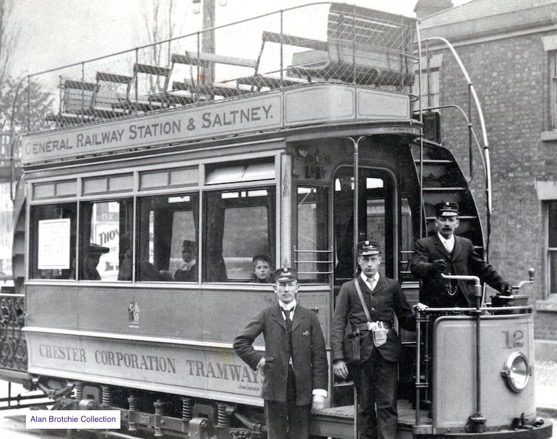
Tramcar No 12, in all probability brand new and still with curtains, pictured at the western terminus at Saltney — photo undated, but almost certainly taken in April/May 1903. Pictured left to right are an inspector, a conductor and a motorman.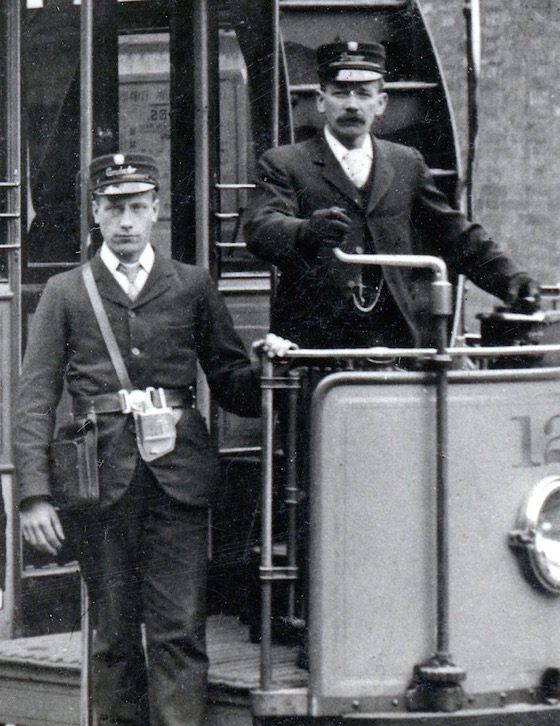
An enlargement of the above photograph showing the conductor and the motorman, both of whom are wearing single-breasted jackets that are completely devoid of insignia, including marked buttons. The conductor's belt has fixings for both his cash bag and the ticket clipper/punch, something which may possibly have been unique to Chester; the buckle is very reminiscent of military practice, so probably had some sort of insignia or device in the centre.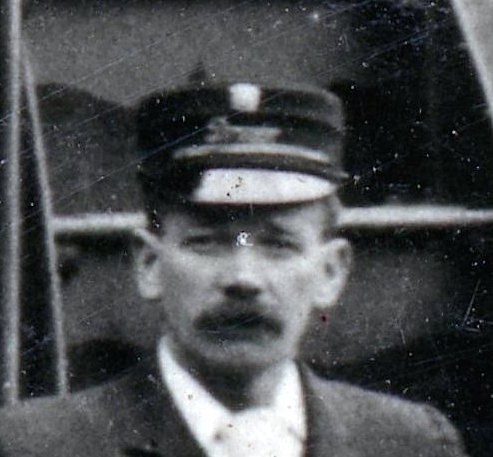
A close-up of the motorman's drooping-peak cap, showing the script-lettering grade badge — 'Driver' — and the small shield-shaped badge above, almost certainly that depicted below.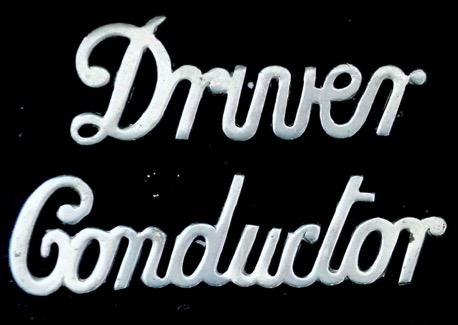
Standard, off-the-shelf, script-lettering grade badges of the type used by Chester Corporation Tramways — nickel. Author's Collection.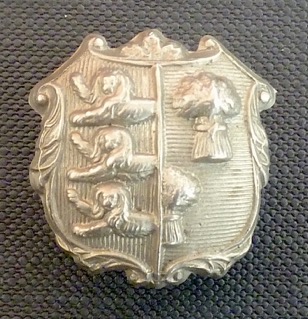
Chester municipal-device badge, almost certainly the same pattern as used by Chester Corporation Tramways — nickel. Author's Collection.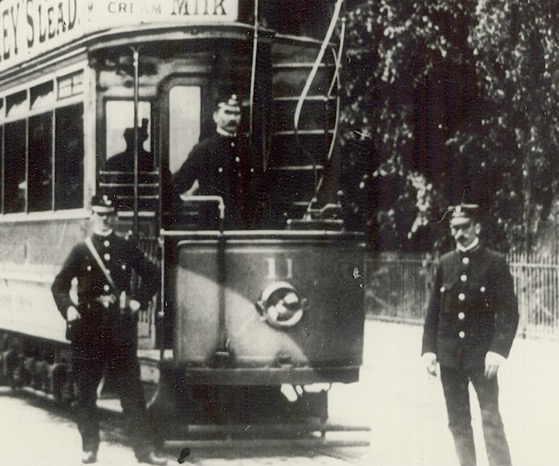
A motorman, a conductor and an inspector with Tramcar No 11 on the approach to Grosvenor Bridge — photo undated, but probably taken in 1904 given the absence of destination boxes. All three individuals are wearing single-breasted jackets with stand-up collars. Photo courtesy of Cheshire Image Bank (see link).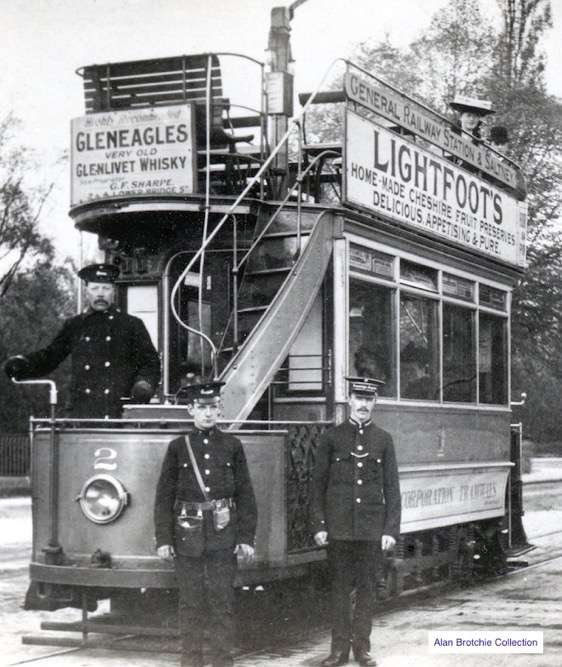
A motorman (No 16), a conductor and an inspector with Tramcar No 2 — photo undated, but probably taken between 1905 and 1907 along Hough Green. The drooping-peak caps had by this time been replaced by tensioned-crown peaked caps.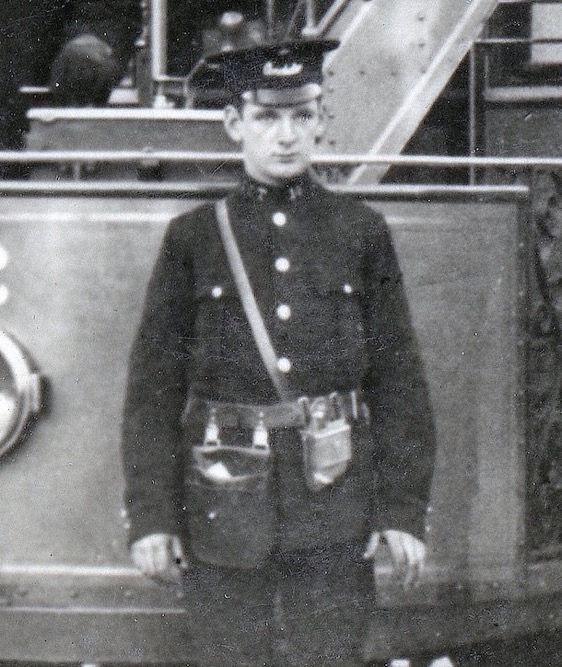
An enlargement of the above photograph showing the conductor. His collar insignia are clearly discernible, 'C C T' and '14'; he also appears to be wearing a similar belt and buckle to the conductor in the first photograph above.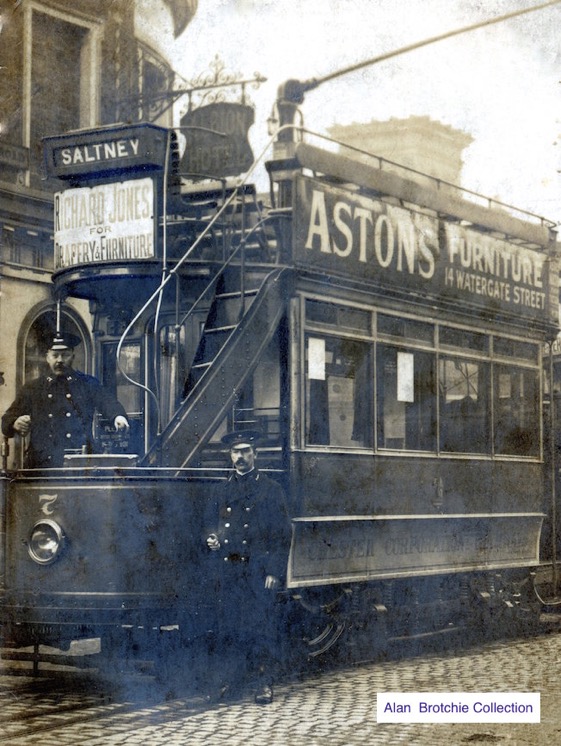
A motorman and an inspector with Tramcar No 7 at the station terminus — photo undated, but probably taken in the late-Edwardian era given the presence of a destination box; these were first fitted around 1907/8.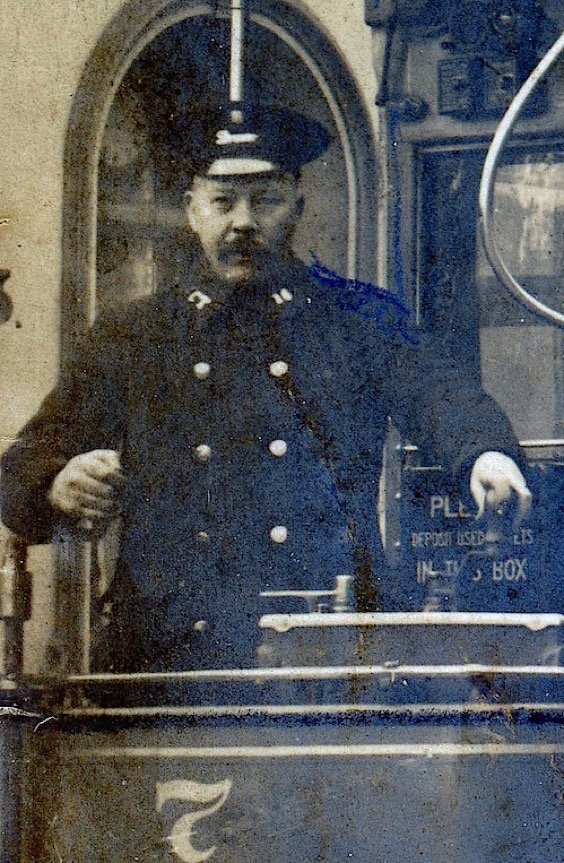
An enlargement of the above photograph showing the motorman — Employee No 16 — the same individual as seen in the photograph of Tramcar No 2 above. The insignia on the greatcoat collars are easily made out.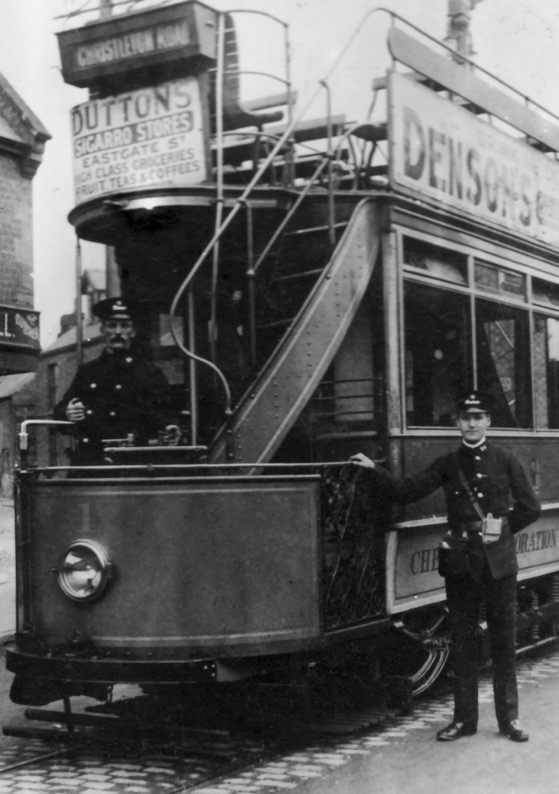
A motorman and a conductor (possibly Employee No 14) pose with Tramcar No 1 at the Christleton terminus in 1907. Photo courtesy of Cheshire Image Bank (see link).
Senior staff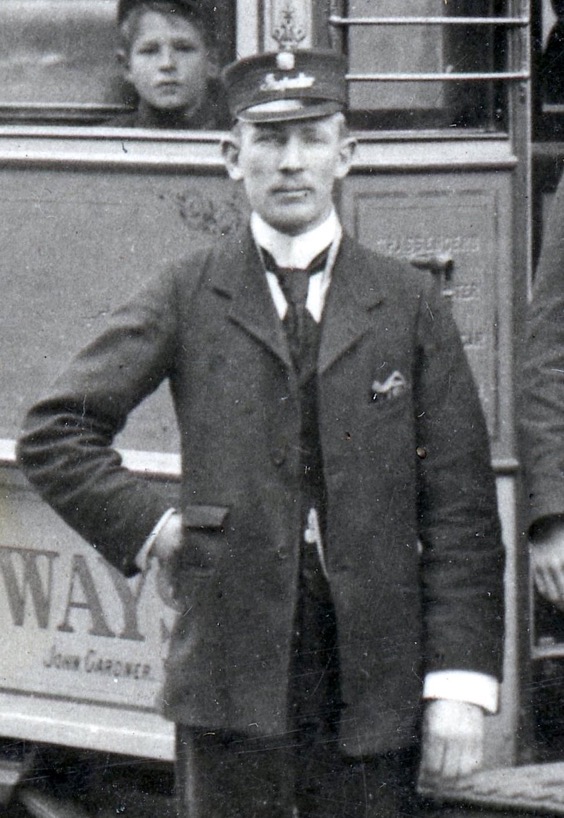
An enlargement of the 1903 Saltney terminus photograph above, showing the inspector, in a drooping-peak cap bearing a metal, script-lettering grade badge.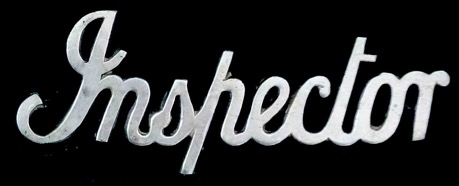
Off-the-shelf, script-lettering grade badge of the type used by Chester Corporation Tramways — nickel. Author's Collection.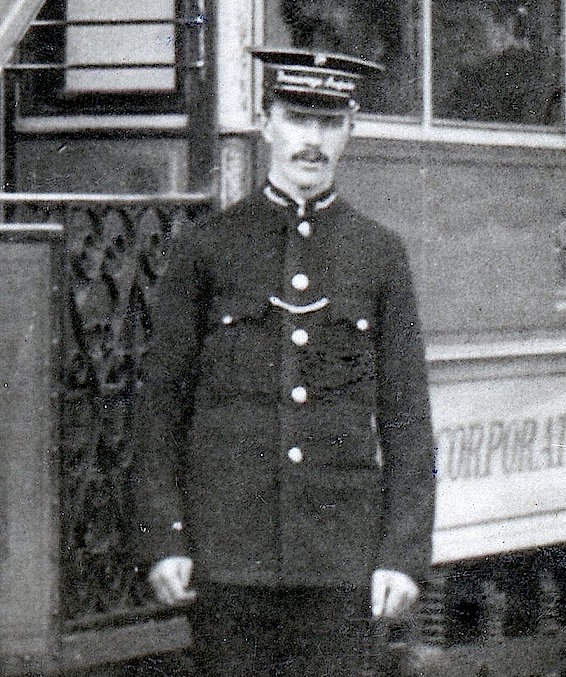
An enlargement of the photograph of Tramcar No 2 above, showing the inspector. By this time (circa 1905-7), the drooping-peak caps had been superseded by peaked caps with an unusually wide, tensioned crown (top); they were elaborately piped, and carried a hat band that bore 'Tramways Inspector' in embroidered script lettering. The jackets were the same style as worn by tramcar crews, but with 'Inspector' in embroidered script lettering on the stand-up collars.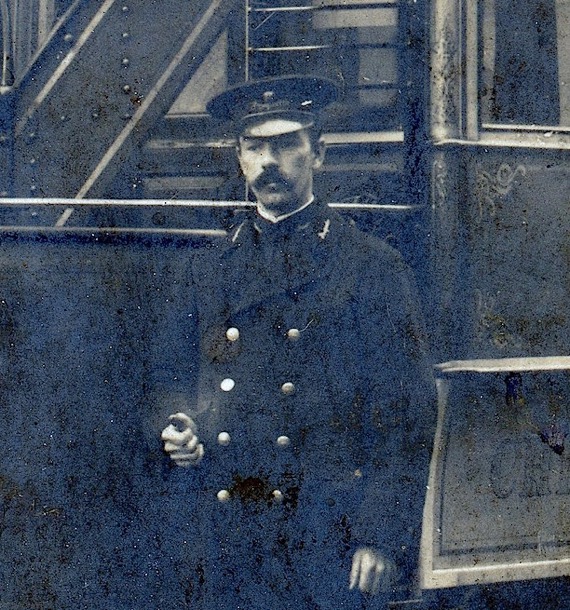
An enlargement of the photograph of Tramcar No 7 above, showing the inspector. The collars on both the overcoat and the jacket (worn underneath) bear the grade — 'Inspector' — in embroidered script lettering. The cap, however, appears to be a good deal less flamboyant than that shown in the previous photograph, foregoing the elaborate piping and grade in favour of a simple embroidered 'Inspector' badge.
Female staff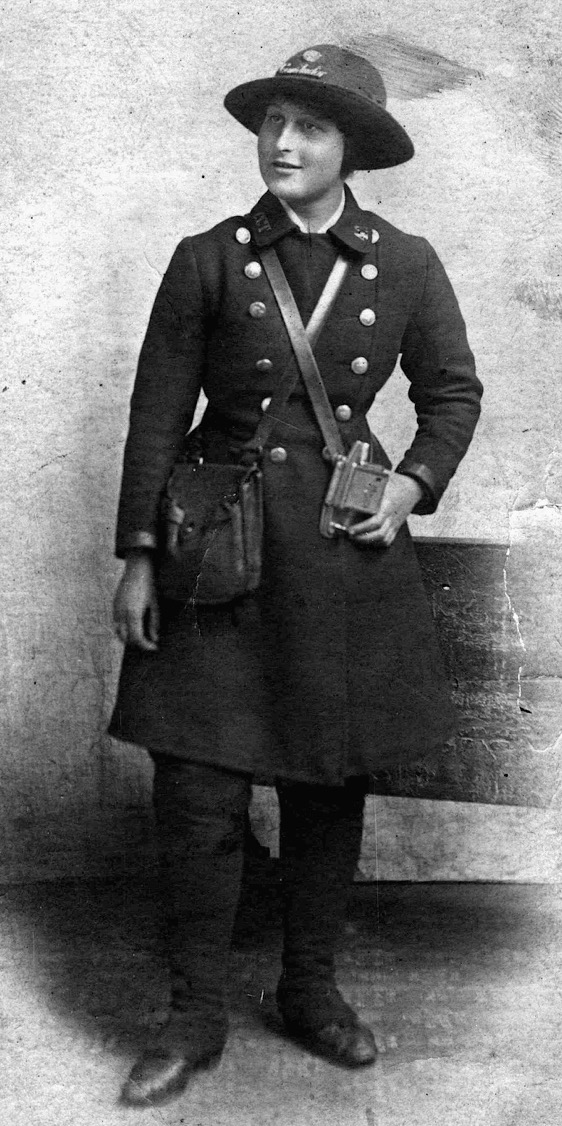
Conductress No 42, Hilda Conway — photo taken during the Great War. Photo courtesy of Cheshire Image Bank (see link).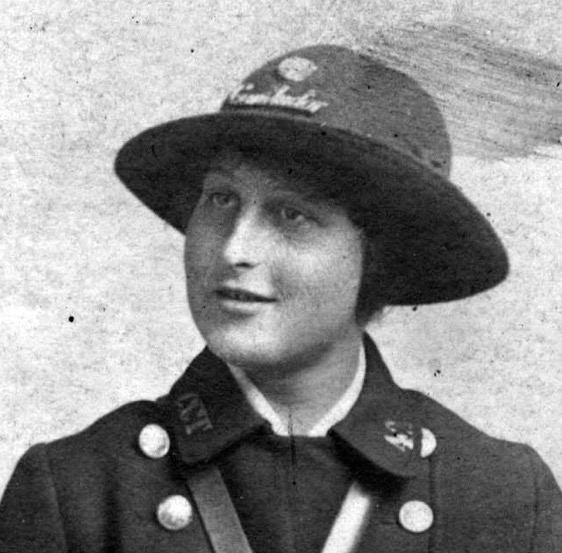
An enlargement of the above photograph showing the uniform insignia. The collars badges — 'C C T' and '42' — are easily discerned; the upper badge is almost certainly a regimental or sweetheart badge, the wearing of which was common place during the Great War.